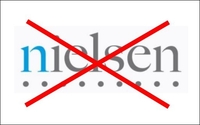Broadcasters Call On Nielsen To Halt Rollout Of 'Hybrid' Local TV Measurement
- by Joe Mandese @mp_joemandese, February 6, 2014

The National Association of Broadcasters (NAB) Thursday called on Nielsen to delay a planned roll-out of a new “hybrid” method for measuring local TV audiences
until it can be “fully tested in the marketplace.”
The request, which was termed “big news” by one long-time broadcast researcher, comes weeks after Nielsen began briefing clients on a major overhaul of its local TV measurement service, including the controversial hybrid methodology.
The impasse also comes a week after one of the nation’s largest broadcasters, CBS, announced an expansion of its long-term contract with Nielsen, which included the hybrid program.
advertisement
advertisement
That wasn’t enough to convince the NAB to give the method a pass, and on Thursday the association released details of a resolution demanding Nielsen halt the process. Interestingly, the NAB said the resolution passed with “unanimous support” by its board of directors during a regularly scheduled meeting on Wednesday. What makes that unanimity so interesting, is that two CBS executives are represented on the NAB’s board: Dan Mason president-CEO of CBS Radio, who serves on the board’s executive committee; and John Orlando executive vice president-government affairs, who serves on the NAB Television Board.
Noting that Nielsen’s hybrid measurement method would serve as “currency” for determining advertising rates in local TV markets, and that the plan also called for Nielsen to add “broadband-only homes” into its local TV measurement samples, effectively reducing the number of “traditional” TV households, the NAB said the effect could “understate actual viewership of local television stations.”
Consequently, the NAB resolution called on Nielsen to “delay implementation of hybrid measurement, methodology and technology until it can be fully tested in the marketplace” and also asked Nielsen to “increase its sample size in local TV markets to make ‘broadband-only homes’ additive to its samples beyond 2014.”
A Nielsen spokesperson did not explicitly comment on whether Nielsen would agree to the NAB’s request to delay the hybrid rollout, but provided an “official” statement implying it would stick with its original rollout plan:
"Nielsen is committed to improving local TV measurement. Increasing sample sizes through hybrid audience measurement will provide more stable ratings and build confidence in the local media marketplace. We will continue to work with many industry stakeholders, including the MRC and NAB’s COLTAM, to review hybrid methodology and technology. It is important to get it right.
“Clients have been promised both preliminary and parallel data phases before the full implementation of hybrid and we have already pushed out our implementation timelines as we work through the required research to support the proposed methodology. We will continue to work closely with the industry on our progress and timelines.”
In a related move, Nielsen added that it recently announced its commitment to “invest in a panel expansion for five local people meter markets” this year.
“We hear the concerns about the inclusion of broadband-only homes in the local TV samples,” Nielsen acknowledged in its statement, adding, “We are currently evaluating several different options to address concerns and we expect to make an announcement in the near future."
As a side note, one broadcast researcher noted that the NAB’s move had the support of COLTAM, its Committee on Local Television Audience Measurement, which is an influential group comprised of local broadcast measurement executives, but that no such group represents the interests of the national broadcast measurement marketplace. The NAB’s CONTAM (Committee On Nationwide Television Audience Measurement) was disbanded in 2003.
“Without CONTAM, where is the body to protect national ratings from similar changes -- other than the MRC,” the executive said, referring to media industry ratings watchdog the Media Rating Council.
Nielsen previously announced a plan to introduce broadband-only households into its national TV ratings sample.


